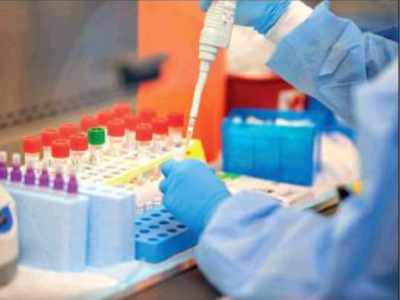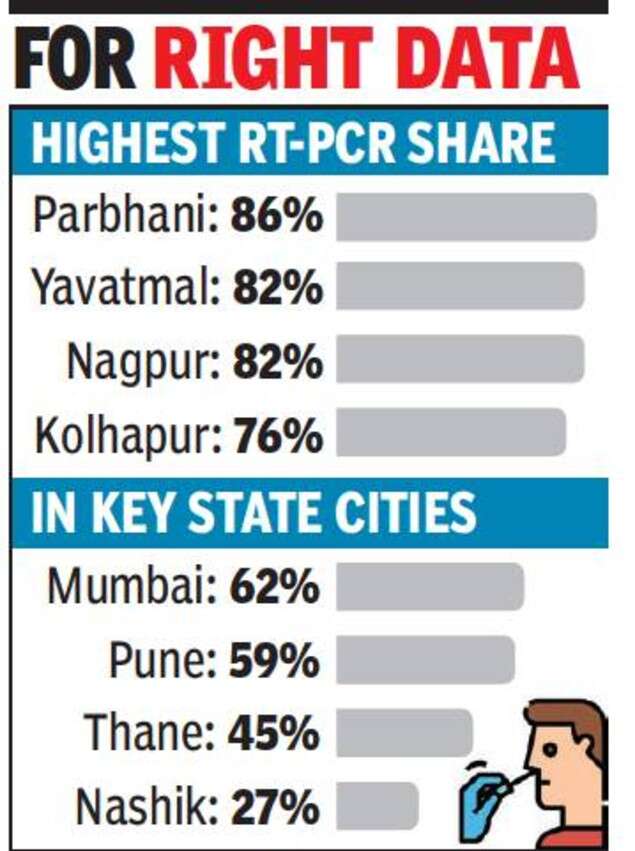50% of Covid tests now RT-PCR across Maharashtra

RT-PCR tests produce much more accurate results than rapid test kits (Representative image)
PUNE: An average of 49.4% of all Covid tests are now being carried out via RT-PCR in Maharashtra, more than 20 days after the state decided to rely solely on RT-PCR testing to decide weekly positivity rates of districts.
State officials said the RT-PCR share went up after existing labs were asked to do more tests — by working in three shifts. Officials also deployed more vans to transport samples from rural parts to city centres.

“With over 250 RT-PCR-capable labs, the state never had a shortage of capacity. Earlier, there was a dip in testing at these labs,” a health official said.
Last month, only 41% of tests were RT-PCR, as most districts deployed rapid antigen tests.
After the order to have more RT-PCR tests was passed by the state government in mid-June, testing levels improved to 43%, 44% and finally, to 49% this week. “The districts that were lagging behind are also now improving their RT-PCR share,” the state official said.
The official added that the aim is to have more accurate Covid-19 surveillance across the state. “We are not asking local authorities to completely avoid RATs as they have their uses. But RT-PCR tests are more reliable when deciding the weekly positivity rate,” he said.
This week, according to data from July 8 to July 14, districts such as Parbhani (85%), Yavatmal (81%), Nagpur (81%), Kolhapur (75%), Gondia (78%) continued to have a better share of RT-PCR tests.
Lab personnel said the pressure on them has eased due to the fall in Covid cases.
“But if cases rise, it will become difficult again to have more RT-PCR tests,” a lab official said.
RT-PCR tests produce much more accurate results than rapid test kits. In early June, an analysis of negative RAT tests that came positive when retested with RT-PCR revealed that the rapid tests had missed up to 33.7% of Covid cases. The study was based on field tests in Mumbai.
At the time, more than 60% of the daily Covid-19 testing in Maharashtra was being done using RATs, preferred by citizens and government for ease of use and shorter turnaround time.
Public health experts have said that over-reliance on RATs — while testing large population groups can results in surveillance gaps.
State officials said the RT-PCR share went up after existing labs were asked to do more tests — by working in three shifts. Officials also deployed more vans to transport samples from rural parts to city centres.

“With over 250 RT-PCR-capable labs, the state never had a shortage of capacity. Earlier, there was a dip in testing at these labs,” a health official said.
Last month, only 41% of tests were RT-PCR, as most districts deployed rapid antigen tests.
After the order to have more RT-PCR tests was passed by the state government in mid-June, testing levels improved to 43%, 44% and finally, to 49% this week. “The districts that were lagging behind are also now improving their RT-PCR share,” the state official said.
The official added that the aim is to have more accurate Covid-19 surveillance across the state. “We are not asking local authorities to completely avoid RATs as they have their uses. But RT-PCR tests are more reliable when deciding the weekly positivity rate,” he said.
This week, according to data from July 8 to July 14, districts such as Parbhani (85%), Yavatmal (81%), Nagpur (81%), Kolhapur (75%), Gondia (78%) continued to have a better share of RT-PCR tests.
Lab personnel said the pressure on them has eased due to the fall in Covid cases.
“But if cases rise, it will become difficult again to have more RT-PCR tests,” a lab official said.
RT-PCR tests produce much more accurate results than rapid test kits. In early June, an analysis of negative RAT tests that came positive when retested with RT-PCR revealed that the rapid tests had missed up to 33.7% of Covid cases. The study was based on field tests in Mumbai.
At the time, more than 60% of the daily Covid-19 testing in Maharashtra was being done using RATs, preferred by citizens and government for ease of use and shorter turnaround time.
Public health experts have said that over-reliance on RATs — while testing large population groups can results in surveillance gaps.
FacebookTwitterLinkedinEMail
Start a Conversation
end of article
Quick Links
Delhi Air PollutionDelhi TemperatureChennai WeatherBangalore TemperatureCovid vaccination centres in DelhiCoronavirus in DelhiRTPCR test in GurgaonHyderabad RainPollution level in BangaloreDelhi SmogDelhi TemperatureNoida AQIGurgaon AQI todayFire in MumbaiMumbai RainsCovid 19 RT PCR Test in NoidaDelhi AQI todaySrinagar encounter
